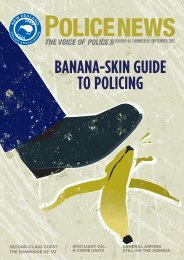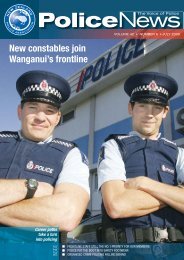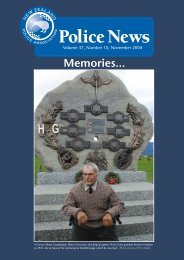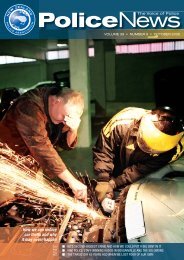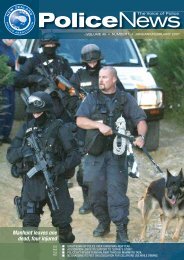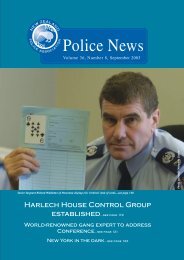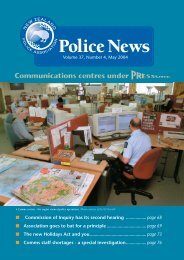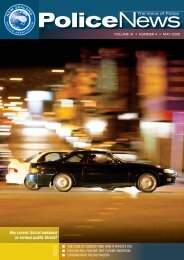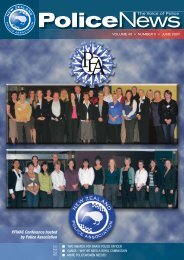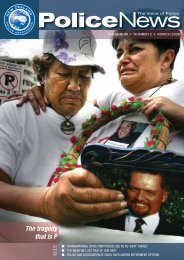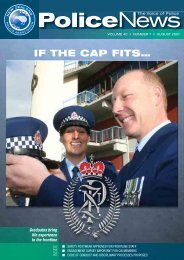'recruits' At dog - New Zealand Police Association
'recruits' At dog - New Zealand Police Association
'recruits' At dog - New Zealand Police Association
You also want an ePaper? Increase the reach of your titles
YUMPU automatically turns print PDFs into web optimized ePapers that Google loves.
The Voice of <strong>Police</strong>VOLUME 39 • NUMBER 4 • MAY 2006<strong>Police</strong> Minister meetsnew ‘recruits’ at <strong>dog</strong>training centre■ HUGE POPULATION GROWTH A CHALLENGE■ 84% OF OFFICERS FAVOUR RAISING DRINKING AGE■ NEW COMMISIONER HAS EYE ON THE FUTURE
<strong>Police</strong><strong>New</strong>sThe Voice of <strong>Police</strong>Critical role of <strong>Police</strong> College acknowledgedduring 25th anniversary celebrationsFrom 30 March to 1 April, The Royal <strong>New</strong><strong>Zealand</strong> <strong>Police</strong> College celebrated its 25thanniversary.HRH Prince Charles, The Prince of Wales,officially opened the Porirua <strong>Police</strong> Collegeon 1 April 1981. Her Majesty The Queenbestowed the title ‘Royal’ five years laterduring the NZ <strong>Police</strong> Centenary in 1986.The anniversary was celebrated with a formaldinner, a more casual ‘mix and mingle’ anda public open day followed on Saturday 1 April.The open day drew thousands of people,particularly parents with young children.Nearly 4500 attended displays set up in theCollege gymnasium.The day’s success was due to “an enormouscombined effort from College staff and stafffrom throughout the country,” said TrainingCommander Superintendent Alistair (Olly)Beckett. “Staff from many different specialistareas came together to pull off a spectaculardisplay of police work for members of thepublic.”Two days earlier, over 180 people hadattended the formal dinner on 30 Marchincluding Prime Minister, the Rt Hon HelenClark, <strong>Police</strong> Minister, the Hon AnnetteKing, former and current <strong>Police</strong> staff andpast wing patrons.On 31 March, the ‘mix and mingle’ providedan opportunity for nearly 100 current andformer training staff to meet and sharestories from their time at the College.The Prime Minister’s addressPrime Minister Helen Clark acknowledgedthe sterling work and professionalism ofpolice officers in her address at the 25thanniversary dinner.“I want to acknowledge the continuedprofessionalism of the <strong>Police</strong> underpressure,” she told the audience.Ms Clark said that the new influx of 1000new police officers, brought about by anagreement with NZ First, meant that theCollege “could expect to train approximately2,800 recruits over the next three or soyears, as well as maintaining senior policetraining for approximately 7,000 staff whowill attend senior courses”.Ms Clark spoke about upcoming changes tothe <strong>Police</strong> Act and said a “wide consultationprocess” would be undertaken.IntegrityThe government was keen to see that NZ<strong>Police</strong>’s integrity is maintained “as one ofthe most corruption-free <strong>Police</strong> services inthe western world,” Ms Clark said.• <strong>Police</strong> College Training Commander Superintendent Alistair (Olly) Beckett with PrimeMinister, Helen Clark, at the formal dinner.• Ring of fire: <strong>Police</strong> <strong>dog</strong>s go through their paces in front of thousands of appreciativespectators at the open day at the College.• “Okay, so how do I make it go faster please officer?” This young girl was particularlyenamoured with a <strong>Police</strong> motorcycle after a formation riding display.- Photos courtesy of Royal NZ <strong>Police</strong> College90May 2006
She paid tribute to the work of the Royal<strong>New</strong> <strong>Zealand</strong> <strong>Police</strong> College and said that it“played a critical role in ensuring that <strong>New</strong><strong>Zealand</strong> continues to have a world classpolice service”.When the <strong>New</strong> <strong>Zealand</strong> <strong>Police</strong> Force wasformed in 1886 there was no structured,co-ordinated training for new officers. Thefirst centralised training began in 1898at the Mt Cook <strong>Police</strong> Station. When thenational training centre moved to Lytteltonin 1953, there was just one instructor,Senior Sergeant Ted Hotham.Today, the <strong>Police</strong> Training Service Centre,which includes the Dog Training Centre,employs approximately 260 staff. In1998 the <strong>New</strong> <strong>Zealand</strong> <strong>Police</strong> joined theAustralian <strong>Police</strong> Professional StandardsCouncil, which aims to improve policeprofessionalism. That was followed, in2000, by an agreement with Wellington’sVictoria University, to provide purposedesigned tertiary courses for police staff.Ongoing trainingOngoing training in specialist areas, andrefresher training courses ensure thatpolice officers continue to develop skillsthroughout their career. Ms Clark saidthat the commitment to higher educationand ongoing training “is very much in linewith our government’s focus on creating aknowledge-based economy and society”.Ms Clark acknowledged that the <strong>Police</strong>had come under intense scrutiny of recenttimes. She said that scrutiny has generatedcriticism, which at times has been “unfairand even destructive”.“Our <strong>Police</strong> Force serves communitieswhich are changing fast and becomingmuch more ethnically, religiously, andculturally diverse. The government fullysupports the efforts the <strong>Police</strong> are makingto recruit across our diverse communities.Also commendable are the efforts the <strong>Police</strong><strong>New</strong> <strong>Zealand</strong> <strong>Police</strong> <strong>Association</strong>• Prime Minister Helen Clarkacknowledged the “critical role” the<strong>Police</strong> College plays in policing.are making to be responsive to the manyethnicities, cultures and faiths in <strong>New</strong><strong>Zealand</strong> today,” she said.Asset seizure legislation provideswindfall to small US <strong>Police</strong> DepartmentThe Pontoon Beach <strong>Police</strong> Department inIllinois will take in $2.3 million as part ofthe largest cash forfeiture ever in SouthernIllinois, according to a recent report in theSt Louis Post-Dispatch.It’s a windfall for the department, whichruns on an annual budget of $1 million.<strong>Police</strong> Chief Charles Luehmann said themoney would be used to buy severalnew patrol cars, upgrade equipment andimprove training.On March 11, 2005, Officer John Simmonswent to the Flying J truck stop after a clerkreported that a tractor-trailer was blockinga driveway.The driver was acting strangely, reading amap that was upside down. His hands wereshaking. His logbook was not in order, soSimmons asked to search the trailer.During the search, Simmons found $3.3million in cash. Ten officers spent 12 hourscounting the cash, which was mostly in $20bills.Cocaine residueCocaine residue was found on the money,which was wrapped in fabric softener sheets.Madison County State <strong>At</strong>torney, Bill Mudge,turned the money over to federal authorities,which began forfeiture proceedings.Mudge’s office will get $263,000, and theDrug Enforcement Administration will get$658,000 as a result.“Here we have a situation where no oneclaimed the money,” said Edward McNally,the US attorney for Southern Illinois.The cash was linked to a Mexicanmethamphetamine trafficking operation.If a search reveals unexplained moniesin vehicles or other property then lawenforcement agencies are entitled to seizethe money. The money is then dividedbetween local and federal authorities, andmust be used for law enforcement.Do you rememberGeorge Wilder?Do you remember George Wilder? Wilder, the subjectof the song: “The Wild Colonial Boy”, gained notorietywith several jail breaks and time on the run between1962 and 1970. Wilder’s exploits are now to be thesubject of a television documentary/drama. If you haveany memories of Wilder during that time and wouldlike to share them, please contact Kim Triegaardt atresearch@raconteur.co.nz or you can ring Kim on021 128 3165. Discretion is assured and if you’d like toremain anonymous that’s fine too.Have you moved recently?If you have or perhaps are about to, please let us know so wecan update your records.You can do this by:• writing to us at PO Box 12344;• calling us on free phone 0800 500 122;• faxing us on (04) 496 6819; or• emailing us at;membership@policeassn.org.nzYou need to let us know your membership number, newaddress and if you’re a serving member - your new station.May 200691
<strong>Police</strong><strong>New</strong>sThe Voice of <strong>Police</strong>Huge population growth set togreatly challenge future policingBy Steve Plowman, Editor, <strong>Police</strong> <strong>New</strong>sOver the next three years, <strong>New</strong> <strong>Zealand</strong> <strong>Police</strong>will welcome with open arms a promised influxof 1000 more sworn police officers – providedit can recruit that many to begin with.The extra police are much needed to bolstera flagging frontline, especially in places likeCounties-Manukau, <strong>New</strong> <strong>Zealand</strong>’s toughestpolicing district, which is woefully understaffedin the face of rising violent crime.Burgeoning population growth in places suchas Counties-Manukau, the Queenstown-Lakes,Tasman, the Selwyn-Waimakariri area ofCanterbury, the Kapiti Coast and Bay of Plentydistrict will impact heavily upon policing overthe next five years. Some of these areas arecharacterised by large housing developments,which are pushing out into surrounding ruralareas.In urban areas, Tauranga and Pukekohe haveshown the greatest growth.The problem of recruiting enough police officersto fill those needs will be one of the single mostsignificant challenges policing faces.Population growthThe highest percentage rates of populationgrowth annually during the June 2005 yearwere in the following regions Queenstown-Lakes (6%), Rodney (2.9%), Waimakariri(2.7%), Selwyn (2.6%), Tauranga City (2.4%),Manukau City (2%), Western Bay of Plenty(1.9%), Kapiti Coast and Tasman (1.7% each),Franklin and Hamilton City (1.6% each), andHurunui District (1.5%).But percentages alone can be misleading. 2%in Manukau adds a lot more people than 6% inQueenstown-Lakes region.Those new communities, one of which,Flatbush, will add 40,000 people to thepopulation of Counties-Manukau districtby 2010 promise headaches for DistrictCommanders and police management alike.Albany is another area undergoing significanthousing growth.<strong>Police</strong> have begun to recruit overseas in a bid toaddress the problem and have also lowered thepreferred recruit age in an endeavour to enticeschool leavers to consider a police career. Therecruiter’s job is not an easy one in today’semployment climate. The Counties-Manukau<strong>Police</strong> District is the southern most of the threeAuckland Metropolitan <strong>Police</strong> Districts. Thereare three large Territorial Local Authoritieswithin the district - Manukau City, PapakuraCity and Franklin District. Counties-Manukaualso provides services to the Otahuhu ward ofAuckland City. The District is structured intofour policing areas, which are in turn supportedby specialist business units from within thedistrict.Violent crime risesCounties-Manukau, which recently recorded asignificant increase in violent crime (17.3%), asopposed to the national average of 6.9%, is acase in point. Violence per 10,000 of populationsaw a 9.9% increase in Counties-Manukau asagainst a national increase of just 0.6%. Thebiggest factors affecting the figures are familyviolence, violent offending and vehicle crime.Between 2002/03 and 2004/05, the populationof Counties-Manukau increased 5.13% from427,125 to 449,035. In the correspondingperiod <strong>New</strong> <strong>Zealand</strong>’s population increased by2.2%.In relation to the increase in violence, afrontline police officer from Counties-Manukautold <strong>Police</strong> <strong>New</strong>s recently that youth gangswere “virtually out of control”. “We havehad situations recently where on a weeklybasis, youth gangs will patrol the streets withsometimes up to 10 cars at a time, looking forsomeone wearing colours they don’t approveof. They then bash the victim and the weaponsof choice are either hammers or axes.”In a recent incident, several youths basheda 16-year-old boy with a hammer and whenthree bystanders tried to intervene, one of themwas hit with an axe. Local police officers saythat violence is often extreme and becomingmore commonplace as youth gangs argue overterritory and ‘colours’.Resourcing problemsCounties-Manukau has been a hotbed ofrecruitment and resourcing problems forseveral years. District Commander SteveShortland invariably gets an influx of newlygraduated constables out of each recruit Wingand they endure something of a baptism of firethere. If you can police in Counties-Manukauyou can police anywhere.The attrition rate in the district runs at 5.3%.The national average is 4.1%.<strong>New</strong> constables cut their teeth in Counties-Manukau but after two or three years manysuffer burn out and either transfer out of thedistrict or resign. There is no length of time thatthey have to stay before they can apply for atransfer.• Inspector Steve Shortland (Counties-Manukau District Commander).- Photo courtesy of The Manukau <strong>New</strong>s.The latest available <strong>Police</strong> human resourcefigures for the district tell the story. Retentionis a big problem. The March figures show that48 recruits were added to the staff complementbut the nett gain for the district was only twoofficers, with 21 resignations and 25 transfersover the same month. For several years staffinghas ebbed and flowed. In June 2004 therewere 683 sworn officers, now Steve Shortlandfinds himself with only 649 at his disposal.It’s as if there is some revolving door, whichswallows up police officers at the same rate atwhich they arrive – and sometimes even faster.There are of course the die-hards who are in forthe long haul; usually long-serving, experiencedofficers who want to make a difference andwho consistently battle the odds. They do agreat job but many are frustrated by whatthey call the “politicisation” of the allocation ofresources.Ratios well behind“The 1000 extra police is just going to takeup population increases around the country,it’s not bringing us up to the ratios that otherjurisdictions have, with us being at the bottom,”one long-serving officer told <strong>Police</strong> <strong>New</strong>s.Manukau city councillor Dick Quax agrees. “Weare doing poorly when it comes to getting ourslice of the police resource cake,” Mr Quax told<strong>Police</strong> <strong>New</strong>s. “The ratios of police-to-populationin Counties-Manukau are bad enough but whenyou get into places such as Otara, Howickand Pakuranga, they are very bad indeed,” headded.92May 2006
<strong>New</strong> <strong>Zealand</strong> <strong>Police</strong> <strong>Association</strong>• Former UK police officers in training at the <strong>Police</strong> College in the “Conversion” Wing. Projections indicate that 23 of them will head forCounties-Manukau later this year.- Photo courtesy of The Dominion Post.Quax says the flow on effect of intergenerationalfamily violence is felt in hightruancy and youth offending rates, gang-relatedincidents, and in assaults and anti-socialbehaviour.Over the years, various <strong>Police</strong> Commissionershave tried to address resourcing problemswithin Counties-Manukau. The latest wasrecently retired Commissioner Rob Robinson,who argued strongly to the government formore resources and also for autnomy for hisDistrict Commanders, complaining, in onereport sighted by <strong>Police</strong> <strong>New</strong>s, that ring-fencingof positions was not aiding the Counties-Manukau resourcing cause.Ratios out of kilterOn a basis of FTEs (full time equaliventsavailable for duty) Counties-Manukau has apolice-to-population ratio of 608 people toevery police officer while the national average isone police officer to 556.It’s no wonder that crime stats in the districtaren’t as rosy as elsewhere.This is why. Counties-Manukau is characterisedby:• low per capita incomes;• historically high and disproprotionate levelsof unemployment compared with thenational average; (12,000 of <strong>New</strong> <strong>Zealand</strong>’s85,000 unemployed reside here).• high rates of welfare dependency;• a disproportionate population of youngpeople;• limited provision of social services andcommunity support amenities;• strained resources within CYFS and mentalhealth agencies;• high density areas of low cost statehousing;• poor health among Maori and Pacific Islandcommunities;“We are doing poorly when itcomes to getting our slice ofthe <strong>Police</strong> resource cake. Theratios of police-to-populationin Counties-Manukau are badenough but when you get intoplaces such as Otara, Howickand Pakuranga, they are verybad indeed.”– Manukau city councillorDick Quax.• poor educational achievement, particularlyamong Maori and Pacific Island schoolleavers, who are being over-representedin statistics for those leaving without anyformal qualifications;• large numbers of dysfunctional familieswhere domestic violence is rife; and• high numbers of solo parent families.District Commander Steve Shortland says thata major issue for him is the ratio in terms ofthe deprivation index and other socio-economicindicators as they relate to the population.“Lower indexed groups generate a far greaterdemand for policing services,” he told <strong>Police</strong><strong>New</strong>s.Other ratios aren’t too hot either.Four Area CommandersIn terms of policing management there are fourArea Commanders – Inspector Bruce Baird,who is responsible for Counties-ManukauWest, which takes in Mangere, Papatoetoeand Otahuhu. Manukau West has a ratio ofone police officer to 1100 people. If you thinkthat’s bad then spare a thought for Counties-Manukau East Area Commander, InspectorNeil Adams, and his staff – there, 99 staffservice a population of 143,960 people inHowick, Pakuranga, Beachlands and Otara). Dothe math – this is one sworn police officer forevery 1454 people – by far and away the worstpolice-to-population ratio in the country. (Source:Counties-Manukau <strong>Police</strong> Business Plan 2004-05).Inspector Alan Shearer has the job of lookingafter Counties-Manukau Central, which servicesManurewa, and his counterpart to the southis Inspector David Montgomery, whose teamservices Papakura, Clevedon and Pukekohe).Their respective police-to-population ratios arealso significantly below the national average.Shortland has the unenviable task of overseeingit all.Manukau is <strong>New</strong> <strong>Zealand</strong>’s second largestcity, boasting a population of 449,035. Some47.9% of the district’s population is now under30 years of age. In areas such as the newMay 200693
<strong>Police</strong><strong>New</strong>sThe Voice of <strong>Police</strong>town of Flatbush and in Clover Park the ratio ofpeople under 20 years of age is expected to be60%. By 2010 the population is predicted toincrease by 13%.Cultural diversityThe diversity of cultures found in Counties-Manukau is mirrored nowhere else in <strong>New</strong><strong>Zealand</strong>. This is a unique place on many fronts.Manukau mayor, Sir Barry Curtis, told <strong>Police</strong><strong>New</strong>s that there are 165 different culturalgroups within the Counties-Manukau district.Approximately 23% of the population are PacificIslanders and 16.43% are Maori. 38.7% of theMaori population in Counties-Manukau is underthe age of 15 years. Just over 12% of all Maoriliving in <strong>New</strong> <strong>Zealand</strong> resides in the district. A2003 report said that the district is projected tohave the largest growth rate for Maori youth ofany of the 12 <strong>Police</strong> Districts by next year.There are twice as many Cook Islanders livingin Counties-Manukau than there are in theCook Islands itself (population 10,000).Just over 31% of residents earn less than$20,000 per year. The national average incomeis $33,280 per annum. (Source: NZ Income Survey,June 2005, Statistics NZ). Just under 17% of the75,000 people, aged 15 years or over, rely onstate aid as their principal source of incomeand 32.3% of the district population havenever finished basic schooling. Historically,unemployment has been more than 10% abovethe national average, although communityleaders say this is falling.Employment• North Island population growth in the last year has been centredaround Auckland, Bay of Plenty and on the Kapiti Coast. -Courtesy of Statistics <strong>New</strong> <strong>Zealand</strong>.Principal employment within the district is inmanufacturing, the retail sector and serviceindustries.NZ <strong>Police</strong> has responded with initiatives torecruit more Pacific Island, Maori and Asianpolice officers to better reflect this diversity butthe initiative is showing signs of foundering.NZ <strong>Police</strong> statistics for January and Februarythis year show that the attrition rate for PacificIsland officers was running at around 8.2%- twice the national average. Last February,the Maori police officer attrition rate was 2.3%,this year it was 5.0%. Recruiting in Aucklandis significantly down and the graduate attritionrate since the end of 2003 is also three timesgreater than normal. Read: Houston we haveanother problem.There could be many reasons for suchan exodus rate but one thing is certain– recruitment is at the heart of it. <strong>Police</strong> haveto draw from a smaller pie than in the past andthat is impacting heavily on the ability of theorganisation to retainMaori and PacificIsland officers.Whereby 10 yearsago, <strong>Police</strong> may havehad 500 applicantsand been able totake the top 20% asrecruits, recruitmenthas fallen off tosuch an extent thatnowadays <strong>Police</strong>may only receive 100applicants and haveto take 95% in orderto fill vacancies. Oneofficer put it this way:“The standards maynot have dropped butthe pool of suitablecandidates hascertainly shrunk. Thatplaces <strong>Police</strong> in theunenviable positionof having to acceptpeople they may nothave in previous yearsbut beggars can’t bechoosers.”SocioeconomicfactorsThere are significantsocio-economic factors that are unique to thedistrict and which impact heavily on policing.Former <strong>Police</strong> Commissioner Robbie Robinsonalluded to them in a November 2002 reportto then Minister of <strong>Police</strong>, George Hawkins,saying: “Ethnic diversity introduces newchallenges in the incidence and types of crimethat <strong>Police</strong> must deal with, staff requirementsand maintaining public confidence.”He went on to say that the situation was“complex and demanding” and that theremust be “sophistication” in the responsefrom <strong>Police</strong>. What has happened is that moregraduates have been earmarked out of eachrecruit wing for deployment to Counties-Manukau. For instance between (Wing 225),which graduated in August 2005 and Wing230, which is due to graduate on May 25,66 of 432 graduates (15.74%) had their firstposting to Counties-Manukau. Of the next twoWings – 231 and 232 (the latter known asthe “Conversion” Wing because it contains 98recruits from the UK) – that percentage is dueto rise to 22%.But with higher attrition rates, police officerburn out and violent crime increasing theremust be those within policing and perhapseven government, thinking that Counties-Manukau is starting to take on the look of abottomless pit.<strong>Police</strong> obviously realise they have problemsand are endeavouring to respond.Domestic violenceA significant increase in domestic violencehas seen police appoint five co-ordinators aspart of a Domestic Violence Response Service.<strong>Police</strong> are targeting repeat offenders; becausethey know that these offenders are likely tocommit other crimes and, in some instances,will go on to murder their partner/spouse orchild.Historically, <strong>Police</strong> have based resourcingdecisions on specific formulae since the1980’s. Those methodologies drew on crimeand incident attendance rates (with weightingsfor certain crimes) and population (includingweightings for certain age groups, areas,road safety requirements and crimes). Since1998 a new model was adopted wherebyapproximately a third of sworn police staff areassigned to districts on a basis of strategicpriority, with the remaining two-thirds beingassigned based on population.The Commissioner retains overall discretionto make staffing adjustments outside thismodel but in recent years changes to totalstaffing have been as a direct result of extragovernment funding. The catch-22 situation,which has come with this new approach, isthat staff funded in this manner have beenring-fenced into specific areas.94May 2006
Ring-fencingRobbie Robinson alluded to just this in hisNovember 2002 report when he said: “Of 375newly-funded sworn staff allocated by strategicpriority, the main beneficiaries have been roadpolicing (285 positions), counter-terrorism (33positions) and youth aid (27 positions).” Theresult has been that the proportion of staff inring-fenced positions has been rising while thestaff allocated through the population-basedmodel in districts has been falling.Robinson told then Minister of <strong>Police</strong>, GeorgeHawkins, at the time: “The task-specific natureof these allocations has been eroding theflexibility historically available to me and toDistrict Commanders to distribute resourcesacross emerging problem areas in a timely andresponsive manner.”Following his report Robinson was given theokay by the government to recruit UK policeofficers to help with the greater Aucklandpolicing problem and 75 were eventuallyassigned there in 2003, 21 of which have sinceresigned from the force. Three are currently onleave without pay (LWOP).Mayor concernedManukau City Mayor Sir Barry Curtis is astrong supporter of policing in the districtand he speaks highly of District CommanderSteve Shortland and his staff. “They do agreat job under very trying circumstances,”he told <strong>Police</strong> <strong>New</strong>s.”But there needs to besome serious contingency planning going intoproviding greater resources for the future interms of servicing the policing needs, whichwill inevitably arise out of having 40,000 extrapeople living in Flatbush by 2010,” he said.Sir Barry is obviously of the view that if thatdoesn’t happen, and start happening prettysoon, then it will very much be a case of lockingthe stable door after the horse has bolted.Curtis waxes lyrical about the new universityand the magnificence of the $49 millionTelstra-Clear Events Centre, the new 1.8kilometre railway link from the North IslandMain Trunk (running from Wiri station to a newstation opposite the new court house and soonto be built <strong>Police</strong> Hub) and of course there willalso be a new multi-purpose arena, which willbe the home of the Counties-Manukau RugbyUnion. The South Western motorway is due tobegin construction later this year.To say Curtis is passionate and proud aboutthe district is like saying that David was awee bit smaller than Goliath. He fairly effusespositivity for the region but while he saysthe Counties-Manukau economy is growingat twice the national average he is alsoaware that such growth brings with it greatchallenges – especially in terms of futurepolice resourcing.Unemployment improvingCurtis says that the unemployment rate hasbeen dropping in recent years and that thereare now more job vacancies than there arepeople to fill them. So why are 12,000 peoplestill unemployed then? You may well ask.It’s all to do with skills – or rather, a lackof skills. Curtis again: “Manukau is themanufacturing heartland of <strong>New</strong> <strong>Zealand</strong> butunfortunately many of the unemployed don’thave the skills for the jobs available, so it’s ourjob to work at upskilling them and the councilis working with WINZ and other agencies toaddress that,” he says.He says that housing developments aregoing up like mushrooms. The council hashad to impose what are known as MULs(Metroplitan Urban Limits) – designed toprevent the continuing outward spread of urbandevelopment onto valuable rural land.Curtis also has concerns about the location ofthe <strong>Police</strong> HQ at Harlech House in Otahuhu,which is in fact in Auckland city. He has longadvocated for it to have a better strategiclocation near the Manukau courthouse.Manukau <strong>Police</strong> HubThe government, for its part, has electedto spend $13 million on the first stage ofthe Manukau <strong>Police</strong> Hub, which is due for<strong>New</strong> <strong>Zealand</strong> <strong>Police</strong> <strong>Association</strong>completion next year. Curtis wants to see atunnel connecting the Manukau <strong>Police</strong> Hub andthe courthouse.“I used to go to the courthouse in OtahuhuDistrict Court and I used to see police officersoperating in the most totally inadequateconditions I have seen,” Curtis says.“The scale of the Manukau <strong>Police</strong> Hub buildingis inadequate to provide for a large, rapidlyexpanding,diverse community,” he adds.<strong>Police</strong> Commissioner Howard Broad recentlyacknowledged the challenges faced inrecruiting the government’s promised extra1000 police officers. Encouragingly, he hasacknowledged the problems that Counties-Manukau faces and the great work the officersthere do in very difficult circumstance and haspromised to address these issues.Perhaps it is fitting then that the final word onthe matter should rest with Minister of <strong>Police</strong>,Annnette King, who told Parliament recentlyin answer to a question about the additional1000 police officers due to come on streamover the next three years: “The deployment ofthat additional resource will go first of all to theplaces that need it the most, so we can tacklethose issues.”There are a few District Commanders andseveral Area Commanders who will be pushingfor those resources as soon as they arrive. Thereare few that will dispute they deserve an evenbigger slice of the resourcing pie than they arealready getting, as they, colloquially speaking,finds themselves well behind the eight ball.Officers in Counties-Manukau and other highgrowth areas will be hoping King’s words signalsome light at the end of the tunnel.As for the future, NZ <strong>Police</strong> is busy assuring alland sundry that contingency plans are in place.For the good of frontline officers and in thehope that they can cut down on the sleeplessnights of some Area and District Commanders– let’s hope those plans are an outstandingsuccess in every way.<strong>Police</strong> Minister not concerned by UK officers’ attrition rate<strong>Police</strong> Minister Annette King has rejectedclaims that the attrition rate among policeofficers recruited from the UK is unusuallyhigh.She was responding to figures, whichshowed that the attrition rate for UK officers,who undertook training in 2003 to bolsterAuckland’s flagging resources, was running at28% - an annual rate of 9.3%, compared withthe national attrition rate of 4.1%.Of the 75 who were originally assigned toAuckland duties, 21 have since left the service.Ms King said that the 2003 intake had shownthat the overseas recruitment initiatives wereworking. Another 98 police officers from theUnited Kingdom began an 11-week conversioncourse at The Royal <strong>New</strong> <strong>Zealand</strong> <strong>Police</strong> Collegerecently.The majority of the recruits are General DutiesBranch officers but there are also 25 criminalinvestigators and16 traffic specialistsamong them.The officers wererecruited from adatabase of around3000 overseas police• <strong>Police</strong> Minister,officers, who hadAnnette Kingexpressed interest inliving and working in <strong>New</strong> <strong>Zealand</strong>.May 200695
<strong>Police</strong><strong>New</strong>sThe Voice of <strong>Police</strong>Southern districts face population challengesBy Steve Plowman, Editor, <strong>Police</strong> <strong>New</strong>sCanterbury District Commander Superintendent Sandra Manderson saysthat the challenge for policing in relation to population growth, such asthe significant growth Canterbury has seen over the last 15 years, is to“police smarter”.That’s not to say that Manderson doesn’t acknowledge the challenges thata burgeoning population in the Selwyn-Waimakariri district promises butshe says that she has contingency plans in place for that expected growth.“There are gaps there in resourcing and we need to address those in areassuch as Lincoln and at the university as well as in community policing, at theprison and in association with WINZ’s Heartland Project,” she said.The Canterbury Region, with an estimated population of 526,300, washome to 53.6% percent of South Island residents. Christchurch cityitself is growing at an annual rate of about 1.1%, the sixth largest in<strong>New</strong> <strong>Zealand</strong>. The national rate of increase has been 0.9% in the latestavailable year (June 2004 to June 2005 figures).Migration driving growthMigration has been the main driving force behind the population growththis decade. Natural increase accounted for 37% of population growth inChristchurch (7,361 people) while the remaining 63% (12,590 people)was a result of overseas migration, including departing and returning<strong>New</strong> <strong>Zealand</strong> citizens, and net migration from other parts of the country.Statistics <strong>New</strong> <strong>Zealand</strong> population projections suggest that Christchurch’spopulation will continue to grow over the next 25 years, reaching 352,100people by 2021. This is an expected increase of 43,000 people, althoughthe growth rate is expected to decline between 2016-2021.The new town of Pegasus is due to provide another 5000 people by2011 but Manderson told <strong>Police</strong> <strong>New</strong>s that she didn’t see Pegasus asthe largest challenge for policing in the district. “Sure we’ll need to takeit into account but it’s a not a big thing on the radar really, the Selwyn-Waimakariri growth is a bit more immediate and we are working on that,”she said.Targeting criminal familiesOne of the ways Manderson and her staff are working smarter isthrough an initiative to target known criminal families. “For instance,we know that two percent of criminals in Canterbury are responsible for20% of the crime. We are adopting a collaborative approach with otheragencies to deal with those crime families and we expect good results,”Manderson said.Also in Canterbury’s favour is that police officers tend to stay there. Theattrition rate is 3.5% as against 4.1% nationally.So Canterbury police are are targeting the 10 top crime families in thedistrict. Canterbury’s top crime family – an extended family of some 67members – have been responsible for costing taxpayers $18.5 million inthe Justice Sector alone. “Sixty two of them have been in jail at one timeor another,” Manderson told <strong>Police</strong> <strong>New</strong>s.Canterbury is also looking at the problems associated with excessivealcohol consumption and how that impacts upon police resources.“Policing in a 24-hour liquor licensing environment is very resourceintensive and we are working at policing smarter in that regard too,”Manderson said.• South Island population growth has been significant in theQueenstown-Lakes district, in Tasman and in Selwyn-Waimakariri.- Courtesy of Statistics <strong>New</strong> <strong>Zealand</strong>.• SuperintendentSandra Manderson(Canterbury DistrictCommander).- Photo courtesy of ThePress.The Queenstown-Lakes District has seen the country’s biggest housingboom over recent years, fuelling an annual population growth rateof 6%. According to Statistics NZ it has seen growth in the last yearof 7.1%. But while the percentages seem large, of course the initialpopulation being dealt with is much smaller than that of places likeCounties-Manukau. 7.1% in Queenstown-Lakes District means an extra1400 people but 2.3% in Auckland, for example, brings another 9,600people for policing to deal with.96May 2006
Queenstown-Lakes District falls within thejurisdiction of Southern District CommanderSuperintendent George Fraser who told <strong>Police</strong><strong>New</strong>s that the figures clearly showed “thatpopulation growth isn’t only a North Islandphenomenon”.With significant projected developments inthe area, Fraser is facing challenges at a localand district level. “It is not only a matter ofproviding community confidence in their localpolicing services, but also a preparedness forthose future demands,” he said.Fraser said that the crux of the matterwas to engage in both short term and longterm planning and the key ingredient wasrecruitment. Like Canterbury, Southern Districtofficers tend to stay. <strong>At</strong>trition is running at just2.2%.Local recruitment“Recruiting from our local communities ofinterest should remain our focus. Thosecommunities will provide a sustainablerecruiting pool, which both identify andrepresent the communities they police. Theopportunity of recruiting experienced UK staffalso contributes to establishing a solid skillsbase for the future,” Fraser said.Queenstown-Lakes is currently meeting itsstaffing targets, according to Fraser.Future projections show that by 2026 therecould be as many as 150,000 people inthe Queenstown-Lakes area on any givenday during peak holiday periods. (Source:Queenstown-Lake District Council).Fraser says that the answer lies incommunity involvement. “Achieving a highlevel of dialogue between local councils,developers and both business and residentialcommunities, remains a key ingredient forlonger term planning. Such a relationshipexists between <strong>Police</strong> within Queenstown-Lakes district and their wider community.As a consequence, informed discussion cantake place at both an area and district level inrelation to future resourcing requirements,” hetold <strong>Police</strong> <strong>New</strong>s.“The challenge for us is to ensure that ourplanning contingencies recognise those longrange predictions and that this growth isreflected earlier rather than later within ourresourcing decision,” he added.Tasman’s steady growthTasman District Commander Grant O’Feetold <strong>Police</strong> <strong>New</strong>s that there had been “steadygrowth” in Nelson and Marlborough. TasmanDistrict Council area has the largest growthwith 2.4% - an increase of 1,000 peopleper year – followed by Nelson with 1.6%, anincrease of 700 per annum.According to Statistics NZ, the West Coastpopulation is projected to have a declinein population. But with huge increases intourist numbers, new mines opening andvast growth in the dairying sector O’Fee will,no doubt, need to take into account figures<strong>New</strong> <strong>Zealand</strong> <strong>Police</strong> <strong>Association</strong>• Superintendent George Fraser (SouthernDistrict Commander).- Photo courtesy of The Otago Daily Times.from the latest census when looking at futureimplications for policing.Tasman District Policing Devlopment ManagerJohn Robinson told <strong>Police</strong> <strong>New</strong>s that the“growth in population is unlikely to be at the‘criminal end’ of society” and was more likelyto come from wealthy British and Europeanimmigrants.He said that the district’s declining crime statsshowed that Tasman was responding well tochanges in the district.Work-Life balance survey represents a golden opportunity for police staffBy Amanda Craig, <strong>Association</strong>Industrial OfficerYour eyes may be rolling at the thought of another<strong>Police</strong> survey…but this one is different andvery important to you and your family. That’sbecause:• this survey is part of a national Departmentof Labour work-life balance project. This is agovernment initiative and <strong>Police</strong>, along with 13other public and private sector organisations,are taking part;• <strong>Police</strong> have external accountabilities andobligations to act on the survey results and totrial strategies; and• The Department of Labour will work alongside<strong>Police</strong> throughout and will evaluate theresults.Your help is neededThe success of the project within <strong>Police</strong> is verymuch dependent on members completing thesurvey. The results will form the foundation fordetermining what work-life balance strategiescould work in the policing environment.The aim of the project is to enable organisationsto identify and trial practical strategies to help staffhave a better work-life balance – so it is about timenot allowances or pay.The survey:• asks questions on whether work-life balanceis an issue, what current work practices makework-life balance easier, what makes it moredifficult and what other things could be done toimprove members’ work-life balance;• will involve a random sample of 2000 staff;• only takes about 15 minutes to fill out;• will enable <strong>Police</strong> to determine a list of priorityissues to be addressed; and• allows <strong>Police</strong> to compare the results againstthose of the other organisations involved in theproject.You can still fill out the survey if you are not part ofthe random sample – all you need to do is look onthe bully board at the end of the first week in May.Sworn and non-sworn staff can participate.Tailored to <strong>Police</strong>A special section on after-hours availability (e.g.standby, on-call etc) has been included to reflectthe demands of policing. While the Department ofLabour survey is generic - so the results can becompared to the other participating organisations- it is flexible enough to include sections relevantto a particular organisation.Confidentiality assured<strong>Police</strong> will not know who fills out the survey. TheDepartment of Labour sends out the survey,receives the replies, collates and analyses theinformation, and then provides <strong>Police</strong> with asummary of the results. No identifying informationis given to <strong>Police</strong> and it will not be possible toidentify what any individual has said.<strong>Association</strong> supportiveThe <strong>Association</strong> is supportive of the project, as werealise this is a key issue for members who aretrying to juggle their commitments to work, family,friends, sport, and study, amongst other things.We are part of the project team and hope to seereal improvements in work-life balance. But firstwe need the information from our members – itsvital to us to have good member feedback.The <strong>Association</strong> is encouraging all members totake the time to fill out the survey, especially therandom sample option.May 200697
POLICE COUNCIL OF SPORTTo contact the <strong>Police</strong> Council of Sport, call Alison Murray at the RNZPC. Ph: (04) 238-3139Scott Johnson outstanding atNational Golf ChampionshipsThe 2006 <strong>New</strong> <strong>Zealand</strong> <strong>Police</strong> <strong>Association</strong>-sponsored National <strong>Police</strong> GolfChampionships were held in Taupo on 13-14 February.There was a full field of 128 golfers, with most making use of the practiceday on 12 February. The practice day was followed by the tournament properwith 72 holes of golf played over the next two days in hot and dry weatherconditions.The Centennial Course at Taupo is always challenging but due to someunforeseen circumstances it wasn’t quite in its best condition, which meantvery few golfers were able to play the four rounds at or near their handicap.Golfers from throughout the country attended and in the end North Islanderstook out the major prizes with Scott Johnson (North Shore) taking the trophyfor best gross score with an outstanding four round total of 284 – four underpar.Mark Smith from Te Awamutu was one of the few players to consistently playunder his handicap, which resulted in him taking the trophy for the best nettscore. He finished 18 strokes under his handicap of 270.The tournament was an outstanding success and the Taupo Golf Clubclubhouse was well attended for the necessary debrief each day, with thelocal caterer putting on a magnificent meal.As always, sponsors are an essential element of any event of this type and theorganisers wish to take this opportunity to thank the <strong>Police</strong> <strong>Association</strong> andthe <strong>Police</strong> Council of Sport for their valuable contributions.Results were:Best Gross Scott Johnson 284Best Nett Mark Smith 270SI <strong>Police</strong> Golf tournament on duringvery busy Marlborough weekendThe South Island <strong>Police</strong> Golf Tournament will be hosted by the Marlborough<strong>Police</strong> Golf Club, Blenheim.The tournament will be held at the Marlborough Fairhall Golf Club, PayntersRoad, Blenheim between 5-7 November, 2006. Saturday, 4 November willbe a practice round day.The 18-hole Fairhall course offers many challenges and is set in idyllicsurroundings amidst hills and local vineyards.This same weekend, Marlborough’s Show weekend takes place and the wellknownHunters Garden Marlborough is also being hosted in Blenheim, sosecuring accommodation early is a must.We advise you to book now if you are intending to come and play. There willbe plenty to entertain partners who are attending, with garden visits and theshow weekend festivities.Please ensure your colleagues are advised of the tournament.For further details visit the following website: www.cherries.co.nz/golfSenior Gross 1. Bob Burns 3082. Clinton Codyre 3093. Rob McCaskie 3104. Davitt Lavery 310Senior Nett 1. Tony Delamere 2912. Philip Caldwell 2913. Neil Forlong 2964. Mike Ledger 300Int A Gross 1. Guy Curtis 3312. Chris Robinson 3363. Matthew Campbell 3424. Ashton Johnson 342Int A Nett 1. Tim Wadley 2922. Darryl Petherick 2923. Peter Crins 2924. Fane Troy 297Int B Gross 1. Paul Horler 3502. Ron Scott 3563. John Tito 3624. Alan Baker 362Int B Nett 1. Warwick McKee 2902. Allan Humphries 2933. Cam Fleming 2994. Mike Owen 301Junior Gross 1. George Staunton 3732. Don Lee 3763. Jay Ferguson 3784. Bruce Ford 381Junior Nett 1. Graeme Hill 2862. Eddie Lyttle 2933. Derek Webb 2974. Tony Manunui 302National Cross-country Champsin Wellington on May 31The NZ <strong>Police</strong> National Cross-country Championships will be held at Battle HillReserve, Pauatahanui, Wellington on Wednesday, 31 May this year, startingat 2.00 pm.The course consists of a circuit of three kilometres. Women runners will dotwo laps (6 kilometres) and the men three laps (9 kilometres).Organiser Glen Turner said that the course was set in scenic surroundingsand would provide a true cross-country environment for runners, with acouple of fences and a hill in each lap.This year’s event will see grades for Open Men, Masters (40-plus; but noM50 grade), Women’s Open and the Masters women’s grade (40-plus; whichreplaces the traditional 35-plus group). There will also be a Draught Horsegrade (95 kilograms and over).Further information and entry forms contact Glen Turner in Wellington viaLotus Notes or by ringing Glen on extension 47696.Visit www.policeassn.org.nz for updated contact details for the <strong>Police</strong> Council of Sport management committee,District Sports Officers and the latest schedule of events.98May 2006
<strong>Police</strong> tennis revival gets underway with Rotorua tournamentThe first <strong>Police</strong> Tennis Tournament to be held formany years was keenly contested at the LynmoreTennis Club in Rotorua from 8-10 March.The tournament was the brainchild of organisersGarth Bryan and Wendy Wrigley and theirdedication to making it happen was evident in theprofessional way in which it was run.There were Open and Social grades (singles anddoubles) for the men. The women played a roundrobin in singles and one game of doubles.Top playersThe Open grade competition included some topplayers from Auckland, Alexandra, Thames andRotorua.The weather was perfect, ensuring all playersenjoyed the three days (and nights!). Plans arealready under way for the 2007 tournament andthe challenge is out for Inspector John Doyle andall South Island players to show their prowess onthe court. Remember, the <strong>Police</strong> Council of Sportcan help with travel for its members. For furtherinformation contact Wendy Wrigley or GarthBryan via Lotus Notes.Results were:Men’s Open singles:Winner - Jeff Sowter (Otahuhu).Runner-up - Mark Osbourne (Otahuhu).Men’s Social singles:Winner - Darin Costar (Tokoroa).Runner-up - Brian Nicholas (Taupo).Women’s singles:Winner - Wendy Wrigley (Rotorua).Runner up - Erin Sykes (Office of the Commissioner).Men’s Open doubles:Winners - Mike Cook (Alexandra) and Garth Bryan (Bayof (Plenty).Runners up - Jeff Sowter (Otahuhu) and Warwick Hands(Thames).Men’s Social doubles:Winners - Darin Costar (Tokoroa) and Brian Nicholas(Taupo).Runners up - Mike Keefe (Rotorua) and Andy Allen (ex-Taupo).Women’s doubles:Winners - Wendy Wrigley (Rotorua) and Jenni-Lee(Bay of Plenty).Runners up - Erin Sykes (OoC) and Anna Jackson(Rotorua).Men’s Open singles plate:Winner – Gavin Leonard (Takapuna).Runner up - Tony Harris (Papakura).Men’s Social singles plate:Winner – Mike Keefe (Rotorua).Runner up - Kim Ratapu (Rotorua).John McEnroe award: Mark Osbourne (Otahuhu).Bloopers award: Jeff Sowter (Otahuhu).Anna Kournakova award: Viv Sutton (Rotorua).Good Sports award: Anna Jackson (Rotorua).Auckland <strong>Police</strong> Volleyball Squad takegold medal at Sth Pacific Masters’ GamesThe Auckland <strong>Police</strong> Volleyball Squad, who playedtheir way through nine games (27 sets), took outthe gold medal in the Social Competitive divisionof the International South Pacific Masters’ Gamesheld in Hamilton from 17-19 February.Setter Si’iva Stanley was outstanding with heraccurate sets, which saw Captain Devan Pillay,along with Sunny Borse, successfully puttingaway many of their spikes. Arran Schuster, whoplayed middle man, met a lot of spikes with someawesome blocking and Dean McMillan providedgreat support, with his final serve taking the teamto a three set, 26-24 win in the final.The squad, despite missing two of their teammates, Lenny Casey and Mike Marsh, also tookout the Hawke’s Bay Masters’ grade in Napier lastyear. The squad is gearing up to try and repeatthe victory in October.They are also entered in the World Armed ForcesSuper Games, which are to be held in Adelaide,Australia in March 2007.<strong>New</strong> <strong>Zealand</strong> <strong>Police</strong> <strong>Association</strong>PLANNINGFOR YOURLIFE AFTERWORK?Are you a member of the GSFor the PSS?If you are, it is important youunderstand your choices. Thefinancial decisions you maketoday can have a major effecton your lifestyle in the future.Getting advice on how tomaximise your <strong>Police</strong> Superentitlement is essential.For a free initial consultation,speak to a <strong>Police</strong> FinancialPlanner today.0800 ON BEAT0800 662 328• The winning Auckland <strong>Police</strong> Volleyball Squad (from back row, left to right) Tony Tumai,Arran Schuster, Sunny Borse, Dean McMillan, Devan Pillay, and Si'iva Stanley.<strong>At</strong>tention sports organisersIf you are organising a <strong>Police</strong> sports event ortournament and want to advertise the factin <strong>Police</strong> <strong>New</strong>s please ensure that you allowplenty of time before your tournament to getdetails to the Editor. Also, we’d love to hearabout how things went and have a copy of theresults for publication. If you can forward somehigh-resolution photos (preferably DPI of 300or above) of competitors, that would be a realbonus. Just one thing – when you forwardresults to Steve at editor@policeassn.org.nzplease ensure they are in a Word documentformat not an Excel spreadsheet format.Thanks very much for your co-operation.Your future. Our focus.May 200699
<strong>Police</strong><strong>New</strong>sThe Voice of <strong>Police</strong>A new homeThis column is written by a frontlinepolice officer. It does notrepresent the views or policies ofthe <strong>Police</strong> <strong>Association</strong>.Well time will tell I suppose, but for us optimists the cup is half full and thosewho take the royal decree always start with the support of the thin blue line.Who would have guessed a ‘Broad Sword’ and a ‘Holy Man’ would be chosento be our new leaders and destined to take us into the future to face whateverthe world throws at us.Both are good southern stock and have had the benefit of experiencing allthings that are good in life due to time in Red and Black country. If this doesn’tgive them a head start, nothing will. Good luck gentleman and rememberwords are cheap and nothing without action!Helter shelterI hear we are so PC these days that we provide ‘bus shelters’ at the college toallow those with a nicotine habit the opportunity to smoke in comfort. I wonderwhether that will creep out into the districts or whether we will continue to useour funds for the great majority and on those things that are really essential. Iknow I might be a bit controversial on this one (there’s a surprise now) but intoday’s world it just seems to me more over the top PCness. And before youyellow fingered lot bag me, I like the odd durrie meself.No room at the innAnd this is the same institution that is ringing around the ‘cake tinners’ whoare attending live-in courses and asking them to stay at home because theyreckon they are so full. Money better spent in this area on giving the greatmajority somewhere to sleep, me thinks, would be a better option.Perhaps we could put another wall up in the bus shelter and put some bunksin there? The hierarchy would call that contingency planning!Intellectual or ineffectualMe mates north of the Bombay Hills are telling me things have got so bad thatthey are now offering frontline NCO jobs without having to have your exams.Yes, you read it right!Now, I knew you didn’t have to have them for the Big Boss’s job but I wasalways under the impression you had to have some consistent standard toget further up the chain. How times (and the chain) have changed. Perhapsthey will need to look at the remuneration for promotion in this pay round andI am sure at the same time they will address the position of those alreadypromoted, to ensure there is no compression (Yeah Right).I also hear that those in northern recruiting have been asked to revisit all theapplicants who didn’t make the grade to see whether they can be slippedthrough the ‘blue gate’ to join our ranks and work towards the promised extra1000. Slippery slope here team but I am sure the ‘Broad Sword’ and his‘Holiness’ will sort this one out before it gets out of hand!A fairy tale endingThat’s what it’s looking like folks with the great Red and Blacks going throughwith perhaps only one hiccup in the first Super 14 campaign. I mean, what’sa little draw in the Perth sunshine. Watch out for it on a Sky channel near you.Poetry in motion!Maybe we just need to swap those Red and Black jerseys for pure black oneswith a little bit of silver fern. Guaranteedto ensure success!We remember… Who passed away…WHITE Jacqueline 26-Mar-06 Widow of retired member GisborneADAMS-REID Lawrence 4-Apr-06 Member PetoneMcKEE James Frederick 4-Apr-06 Retired member RangioraMcCRACKEN Loloma 4-Apr-06 Retired member AucklandSTUART Neil 11-Apr-06 Retired member Te KuitiWILLIAMS Leonie Therese 19-Apr-06 Wife of retired member OhauRAINEY Colin 22-Apr-06 Retired member Mt MaunganuiHINDS Helen Maureen 26-Apr-06 Wife of member OtakiHIGHSTED Denis Patrick 29-Apr-06 Retired member Christchurch1 2 3 4 5 67Clues:Across:1. Someone winning (6)4. Fundamentals (6)8. Medal intended primarily for civilians (6,5)10. Insects, or just eavesdrops (7)11. Friend, mate (3)12. Semi circles (4)13. Fashionable, chic (slang) (3)14. Anything that points the way; indicates something (4)17. Particle formed with a neutral atom (3)18. In a line, perhaps also in the same attire (7)19. Cue exertion forms someone who carries out asentence (11)20. Political party (6)21. Idle talk (6)Down:1. Made into law (13)2. Cancelled O.E.’s to reform his youth(11)3. Borders, fringers etc (6)5. Excite or incite maybe (6)6. Suitable for rifle or even a purse (8,5)7. Marked by bitterness (11)9. Adds to a deficiency (11)15. Writing desk with drawers (6)16. Pizza or just a game counter (6)8 910 1112 13 1415 1617 18April answers:Across1. Amps3. Assisted9. Decided10. Ounce11. Connoisseurs13. Elders15. Asylum17. Etymologists20. Avian21. Outline22. Resisted23. KeysDown:1. Addicted2. Pecan4. Stress5. In one’s sights6. Tendrils7. Diet8. Adjournment12. Smashers14. Details16. Alcove18. Seize19. Fair1920 21100May 2006
<strong>New</strong> <strong>Zealand</strong> <strong>Police</strong> <strong>Association</strong>A wider perspectiveby Ricky CollinsI am a big fan of <strong>New</strong> <strong>Zealand</strong> wines and amexcited about the progress being made by ourwinemakers. However, to get a true perspectiveon how good our wines are relative to otherwine producing nations, I believe it’s importantto try wines from other parts of the world. For those of you interestedin learning more about wine, I urge you to be adventurous and stepoutside of your comfort zone. There’s a whole world of wine styles andvarieties out there that you’ve probably yet to experience.European wines are quite different in style to the wines that most <strong>New</strong><strong>Zealand</strong>ers have become familiar with and accustomed to. They aremore about texture and structure than about the dominant fruit flavoursfor which we are renowned. They are wines that compliment ratherthan compete with the flavours of food to which they are matched.There are plenty of <strong>New</strong> <strong>Zealand</strong> wine importers that are bringing insome marvelous examples of European wines that will not break thebank. Below are some notes on a few I’ve recently tried and enjoyed.Donna Marzia Malvasia Bianca 2004 RRP $17This Italian dry white wine is a blend of 85% Malvasia, and 15%Chardonnay. It’s a vibrant refreshing wine with delicate lemon andstonefruit flavours, crisp acidity and some mineral tones that make itstand out as something a bit different to our Chardonnay. It is made todrink young and is well matched to seafood. It’s available from WineDirect, which is based in <strong>New</strong>market, or from specialist wine stores.Sobreno Finca Tinto del Toro 2004 RRP $19This red wine from the Toro region of Spain is a very attractive exampleof the Tempranillo, the variety that the Spanish region of Rioja madeworld famous. It has a vibrant crimson hue, spicy aromas and a rich,warm palate. There are berryfruit flavours, good acidic structure and anappealing sweet finish. It is brought into <strong>New</strong> <strong>Zealand</strong> by Negociantsand should be available in specialist wines stores.Chateau Belles Eaux Tradition 2003 RRP $15This red from the southern French region of Languedoc is a blend of40% Grenache, 40% Syrah and 20% Carignan. The Languedoc isa region renowned for well-made, well-priced wines, and this is noexception. It’s a medium-bodied, spicy wine with surprisingly impressivestructure for its price. The blend of alluring aromas, blackberry andplum flavours, fine tannins and a healthy level of acid make for a mostinteresting wine. It’s available via Wine Direct.Lamura Nero d’Avola 2003 RRP $102003 was a stinking hot vintage acrossEurope, which wasn’t great for some of thecooler climate wines, but did remarkablethings for those varieties that enjoy plentyof heat, and this is one of them. Sicily isthe home of the Nero d’Avola variety, andthis example from the producer, Lamurais a medium-bodied wine with fresh plumand raspberry flavours, and a deliciousspicy finish to it. It grows to another levelwhen matched to a tomato based pastadish. It’s a steal at this price. Again, thiswine is available through Wine Direct.They have a fabulous user-friendly website• Lamura Nerod'Avola 2003…a‘steal’ from theSicilians.and have regular specials on European wines. Check them out onwww.winedirect.co.nzHOLIDAY HOME AVAILABILITY– for bookings see: www.policeassn.org.nzMay June JulyPAIHIA............................................ 8-9, 15-9,16, 21-23, .....................................5, 6, 8, 10, 11-12, 14-15, 20-30 .............................1, 10-11, 16-20, 23-27, 30STANMORE BAY ............................. 8-11, 14-25, 27- 31 .......................................1-9, 13-30, .............................................................1-6, 8-31AUCKLAND .................................... 10-11, 22-24,30-31 ......................................1, 6-8, 11, 13-15, 21-22, 27, ..................................23-27, 30-31WHANGAMATA ............................... 8-11, 15-18, 22-25, 28-31, ............................1-3, 5-15,18-29, .....................................................1-2, 5-27MT MAUNGANUI ............................ 8-11, 13-16, 18, 21-22, 29-31 .......................1, 5-7, 9, 11-15, 21 -22, 24-30 ...............................15-31OHOPE ........................................... 8-11, 14- 18, 22-31 .......................................1, 10-11, 15-30 .......................................................1, 9-14, 16-31ROTORUA ...................................... 8-11, 14-17, 18, 21-25,28-30 .......................1, 5-7, 11-16, 18- 22, 24-30 ...................................9, 16-20, 24-31TAUPO ........................................... 14-17, 21-25, 28-31 ......................................1, 5-8, 11-15, 18- 22, 25 -29 ..................................7, 10, 16-20, 23-28, 30-31TURANGI ........................................ 8-9, 11-12,14- 18, 20-25, 28- 31 ..................1-2, 5-8, 12-29 .......................................................2, 16-20, 23-27,31NAPIER .......................................... 8, 11, 17-18,21, 28-31 ..................................1, 6-8, 12-15, 18-22, 25-29 ....................................16-20, 23-27, 30- 31PARAPARAUMU .............................. 8-11, 14, 16, 18, 21-24,29 ............................1,5-8, 12-15, 18-20, 26-29 .....................................2, 13, 15-20, 23- 31GREYTOWN .................................... 8, 15-18, 21-23, 25, .....................................1, 6-8, 11-15, 18-22, 26- 29 ...................................6, 19-20, 23-27, 30-31WELLINGTON ................................. 10, 14,16, .....................................................1, 5-8, 13-16, 25- 27 ...............................................16-20, 24-27,30- 31NELSON ......................................... 8, 11, 16-20, 24, 28- 31 ................................1, 5-30 ....................................................................1-2, 15-31HANMER SPRINGS ......................... 14, 17-18, 22- 23, 25-26, ..............................13-15, 18-22, 26-27, ...............................................19 -20,24-25,CHRISTCHURCH ............................. 8, 10-11, 14-15, 18, 24-25,30 .......................13, 15, 22, 28-29.....................................................1-2, 16-20,26-28, 31TEKAPO ......................................... 8-11, 14, 16-18, 22-26, 28-31 .......................1, 5-8, 11-12, 18-21, 26, 28-30 ..............................9,19,WANAKA ........................................ 8-10, 14-15, 17-19, 21, 24, 26-31 .................1,5-7, 13-15, 18-20, ...............................................9,CROMWELL ................................... 8-9, 14, 16-18, 21-25,31 ...............................1-2, 5-6, 11-14, 18-22, ..........................................13, 24-27,QUEENSTOWN ......................................................................................................1, 9, ........................................................................24-25TE ANAU ........................................ 8, 10-11, 14, 17-25, 27-31 ............................1, 5-29 ....................................................................2-30DUNEDIN ....................................... 9-10, 17, 19-23, 25, 28-30 ............................1, 5-8, 11-28 ...........................................................1-2, 9-14, 16-20, 23-27, 30-31May 2006101
<strong>Police</strong><strong>New</strong>sThe Voice of <strong>Police</strong>Write it here! Letters to the Editor are welcome.Signed letters are preferred, but in all cases the writer’s name and address must be supplied. Names will be published unless there is a goodreason for anonymity. The editor reserves the right to edit, abridge or decline letters without explanation. Email to: editor@policeassn.org.nz orwrite it to the Editor at PO Box 12344, Wellington. Letters under 400 words are preferred.Goodwill is wearing thinI have been told that both the <strong>Police</strong>Commissioner and myself have somethingin common. After my letters to <strong>Police</strong> <strong>New</strong>sand probably this one as well, we have bothgone as far as possible within the <strong>New</strong> <strong>Zealand</strong><strong>Police</strong>. So be it.Once again, I write to express frustrationabout the way we are going and the things thatare so plainly obvious but which we allow tohappen anyway.We had a few visitors to our station the othernight and talking around the table as cops do,we called it as we see it. No bullshit, just thefacts. I found that not only are we understaffedbut many others are as well. All are workingovertime, coming in on days off just to tryand get ahead and, as long as we do this, thepowers-that-be will continue to let it go onand say there’s no problem.But they should be aware that goodwill is fastrunning out. I have been called out a numberof times to assist my fellow officers and I do itnot for the <strong>Police</strong> but for them, my workmates.But who wouldn’t go when called to help out acolleague in trouble?As in the past, I have gone on about staffing inmy station. Of a staff of 10 we have been downto one working. On one occasion the officerworking had to go to a job in an out station 90kms away and while there called out a jailerto go to another town to protect the scene ofanother job until he could return. Doing a dayshift and then covering the late shift on call ishappening time and time again.My boss and his boss agree we need more staff.They have gone to their boss and he agrees weneed more staff too but the old story is therearen’t any staff to fill the position.I don’t mean any disrespect to those workingin the top half of the country but my uniformis the same as yours, yet we all hear about theproblems about the top half of the country andnothing about the rest and indeed the sameproblems exist all over not just there. We needstaff all over and we need them now, not aftersomeone decides to hold a survey to find outabout numbers.The good thing about frontline cops is theyhaven’t got time for bullshit. They call it theway they see it and have nothing to gain bylying or pretending.As for recruiting staff to the job, the best peopleto get others into the job are the frontliners. Butwho amongst us would encourage anybody tojoin the job at present?TJF is what’s banded around our smoko tableand I bet it’s not the only table it gets thrownaround either.<strong>Police</strong> Ten-7 is another great advert for notjoining the job. Who in their right mind isgoing to give up a better paying job to joinus and deal with the crap we deal with forpeanuts?We need a decent pay round, more staff andan injection of some good morale.Good luck I say. Be safe out there.Mike Colligan(Alexandra)Two overt and onecovert the way to go?Firstly, well done to the <strong>Association</strong> that putsufficent pressure on the Department andgovernment to issue frontline staff with moreprotection than a polyester shirt. Nice work!One issue though, can anyone tell me whyfrontline GDB staff are being issued with one“overt” carrier and two “covert carriers” for thenew vests.Commonsense tells me that the overt vest whenworn on every shift is likely to be exposed toblood, booze, vomit, dirt, and every othercontaminant that frontline staff face daily.Is the answer that we take it home and wash ordryclean it perhaps?Surely two overt vest carriers and one covertcarrier for frontline staff is the way to go.I could understand the current issue policyif I worked in the CIB, but has anyone reallythought this through?I can see hundreds of overt carriers beingordered by frontline staff and at what costto the department? Are we able to exchangea covert carrier for an overt carrier free ofcharge?It seems like a simple answer to an issue thatappears to have been overlooked.Ryan Mitchell(Oamaru)Superintendent Tony McLeod replies for<strong>Police</strong>: SRBA was thoroughly evaluated overfive trials (six months in total) involving40 staff. Soiling of the overt covers was notan issue. Staff found they could wear theovert covers for a substantial period of timewithout the need for washing.The covers are designed to be washed in adomestic washing machine. They should thenbe dried on a hanger. Domestic dryers arenot recommended - nor drycleaning.Covers, which cannot be satisfactorilycleaned, will be replaced.Two covert covers have been providedas some staff may choose to wear covertagainst the skin, hence the need for morefrequent washing. Additionally, some staffare frequently and unexpectedly required toswitch between uniform and plain clothes.Decisions relating to the SRBA have beenmade after discussions with the 20 trialistswho evaluated the SRBA before the finalselection, the SRBA Working Group and theUniform Committee. The <strong>Association</strong> hasrepresentatives on both of these.Honouring those who died on dutyRecently I had the pleasure of attending myson’s graduation from the <strong>Police</strong> College.While there I made my customary trip to thememorial wall to pay my respects to memberswho have paid the ultimate sacrifice.I have done this several times over the past 25years, not as often as I used to, having been out ofthe job for 14 years. But can someone please tellme why the wall only has the names of membersmurdered in the course of their duties?I would not for one second wish to diminishthe ultimate sacrifice these brave men havemade but I, with many other serving and exmembers,still remember other members whodied in the execution of their duty as well, beit by drowning, motor accidents, helicopteraccidents etc.I feel they are not recognised by the <strong>Police</strong>, asthey should be with plaques on the memorialwall.To the families, friends and colleagues there isonly death, no degrees of it, to cope with aftersuch tragedies.The military do not discriminate betweendeath in combat and death by other means onduty, so why does the <strong>New</strong> <strong>Zealand</strong> <strong>Police</strong>?Having been to more than my share of<strong>Police</strong> funerals of members murdered orotherwise killed on duty, I can attest that theoverwhelming sense of loss is still the same.Rob Rattenbury(Wanganui)Superintendent Alistair (Olly) Beckett,National Manager: Training andProfessional Development replies: Thanksfor your inquiry, which touches on an issuethat saw much discussion and consultationwhen the memorial wall was established onthe occasion of the <strong>Police</strong> Centenary in 1986.<strong>At</strong> that time, it was decided to list officersslain by a criminal act on the memorialwall and all staff, sworn and non-sworn,who have died in service since <strong>New</strong> <strong>Zealand</strong><strong>Police</strong> are remembered in a book displayedin the <strong>Police</strong> College reception area.You will be interested to know that a projectis currently under way to redevelop the102May 2006
memorial wall. A working group, which Iam leading with the assistance of RetiredSuperintendent Paul Mears and comprisingcurrent and former staff and a <strong>Police</strong><strong>Association</strong> representative, is reconsideringthe criteria around who is named on thememorial wall. One of the objectives is togive wider recognition to those who havesacrificed their lives on duty. I will ensureyour views are put before the group andplease contact Paul at the <strong>Police</strong> College ifyou would like to discuss things further.Doing the right thingAny thoughts that I had that I was not just anumber in the eyes of the department wererecently extinguished.In January this year, after serving 17 years inthe <strong>Police</strong> in Auckland and Dunedin, I decidedto leave.Thinking that I was doing the right thingby the department, and not wanting to takeseveral months stress leave and then medicallydisengage, I transferred over from the GSF tothe PSS, and retired. I thought that this wasthe whole point of the GSF—PSS transferbeing introduced, to allow members to leaveand receive their full entitlements.Imagine my reaction when I received a phonecall from HR five weeks later telling me thatmy retirement had been turned down due tothe fact that I had not served 20 years, and thatWayne Annan the HR Manager, thought I wastoo young to retire.They told me that I would have to resign andthat I would not be receiving any retirementleave.Under the <strong>Police</strong> Act, any staff member whohas completed more than 10 years service,is entitled to retire, and receive his/herentitlement of retirement leave. For me thiswas approximately 50 days or approximately$16,000 worth.This appears to have been an arbitrary decisionmade by Mr Annan in about November lastyear in an attempt to save money.I recently received my Certificate of Servicefrom Acting Commissioner, Steve Long. It waswith a bit of a chuckle that I read, “Completed17 years four months of faithful service”. It isa pity that the department did not acknowledgethat “faithful service” by allowing me to leavewith that which is mine.The retirement leave component works out toapproximately three days per year of service. Isthis too much to expect from the Department?I think not but apparently so.The damage being done to me, and the 60or so others who are in the same position, ishuge. Any thoughts that the <strong>Police</strong> were a goodemployer are gone, (if they were ever there inthe first place). And would I recommend the<strong>Police</strong> as a career? Clearly not.The feelings, which I am now left with towardsthe <strong>Police</strong>, are those of anger, resentment anddisappointment. Rather than trying to leavegracefully and on good terms, I am now forcedto battle through the courts for something,which I feel entitled to.My advice to other staff thinking about leavingis to do so, but do it the old way. Take thestress leave and medically disengage. It ismuch simpler and you will get what is yours.To the department and Mr Annan I would say,change your stance. Look at the big picture.Andrew Ferguson(Dunedin)A day in the life ofa senior constableI start work work at 7 a.m. and attend ourregular meeting over a cup of coffee. I havejust sat down when an excitable detectivecomes running in. While gripping onto asearch warrant he yells out in his motherland tongue (Geordie). After telling him tospeak English we are made aware that theoccupant of the address that he has a warrantfor, is in the process of moving out. Two othercolleagues and I follow him to the address.The suspect answers the door, and before thedetective could utter the words “warrant” theman begins to cough.The detective takes the offender back to thestation while we finish the search and completethe scene examination.10.20 a.m. – I return to the station and decideto telephone a Neanderthal to lock up byappointment. The silly man believes that hecannot be arrested because the Family Courtsaid so. The man is not listening to me so,accompanied by a detective with the same levelof service (18+ years), we go to the offender’saddress.We initially do not get a warm welcome,with the offender threatening that he will setthe <strong>dog</strong>s on us. He is on the telephone to hislawyer using many expletives during theirconversation. The detective and I are able totalk him down from his verbal rampage.I take him back to <strong>New</strong> Brighton <strong>Police</strong> Stationwhere I interview him. He tells me all, afterwhich I complete the prosecution file for courtat 2.15pm. I transport him to ChristchurchCentral and put him through the books. Afterformally cautioning him, he thanks me forarresting him.12.40 p.m. - On my way back to <strong>New</strong> BrightonI assist ‘I’ car staff in relation to an offender’svehicle. After about 30 minutes I K8 the job.I get back to <strong>New</strong> Brighton and start eating mysandwiches and am approached by the juniorof the office. He informs me that the bosshas asked for another member of the squadto assist him in dealing with a sudden death.(Our CIU (Combined Investigation Unit) dealwith all sudden deaths in the northern area).1.40pm – We arrive at the deceased’s home.The ‘I’ car sergeant approaches me. Afterobtaining the information from him, Iapproach the family and offer my condolencesand apprise them of the processes involved.I enter the room and find the deceased at theend of his bed. It appears he has been there forsome days, as my shoes are crunching maggotsinto the carpet.Once I am satisfied that there are no suspiciouscircumstances, the undertaker is called.<strong>New</strong> <strong>Zealand</strong> <strong>Police</strong> <strong>Association</strong>When he arrives we decide to use a body bag.The junior constable has the feet; I have theupper part of the body and the undertakerthe middle. “One, two, three”, is the call andwe turn the body into the bag. The stench ofammonia and body fluids hit my nostrils, andI find it difficult to breath. I hold my breath aswe zip up the bag.I roll up the large floor rug that the deceasedhad been lying on, and pull it outside. I askthe deceased’s son-in-law for some fly sprayand begin to spray the maggots. The roomis infested and they have even managed to getinto all the wardrobes.I have drafted the form 47 and leave the juniorboy to get the shift typist to type up andforward the file to inquests.I get back to the office and speak to the boss.It is then I notice a couple of maggots crawlingin the cracks of the sole of my shoe. To theamusement of my boss, I flick them out usingmy pen.I get home and walk the <strong>dog</strong>. I still can’t get ridof the smell in my nostrils, or the taste in mymouth. During the walk a midgy gets stuck inthe back of my throat and I start dry wretching,knowing only too well that it would be easyfor me to vomit.I get back home and have a shower, afterwhich the nostrils are a bit clearer.I reflect on my day. I start wondering whythe CIU is no longer valued, unlike someother branches. I too spent some years in oneof those specialised fields, and nothing haschanged within that unit. I believe the role of auniform CIU constable requires a considerableamount of skill, tenacity and dedication. Couldsomeone who is in the position of makingchanges, please talk to me and tell me why mycolleagues and I are not worth ‘H’ Band?Mike Burnett(<strong>New</strong> Brighton)The Blue Knights and thefinger of suspicionIn the December issue of <strong>Police</strong> <strong>New</strong>s I read thebrief advert for the Blue Knights and thought“Hmm, might be a good thing to belong to, abunch of like-minded guys to go riding with,no worries about attitudes, being harassedby a drunk whinging about a ticket he got in1997 etc, etc.”Then I read the response in the March issuefrom Messrs Olsson and Watkins and wonderedhow they made the quantum leap from readingthat advert and figuring out the Blue Knightswas an OMCG (Outlaw Motorcycle Gang) inblue? Did they even research the Blue Knights?Maybe do a Google search?I am a member of two other motorbike groupsand one (HOG) almost fits their descriptionof an OMCG, to whit: patches, national andinternational structure, terminology, eventssuch as poker runs/charity runs, riding HarleyDavidsons and so on.Yet HOG (Harley Owners’ Group) is wellrecognised and accepted by the public andnever mistaken for a ‘gang’.The public doesn’t know that “the three pieceMay 2006103
<strong>Police</strong><strong>New</strong>sThe Voice of <strong>Police</strong>patch is internationally recognised as a criminalgang symbol” - most people have no idea aboutgang nomenclature, structure or insignias.And I have seen several CMC (ChristianMotorcyle Club) members at rallies I haveattended, nobody cringed from their patch infear - even when it had the words ‘WarriorsOf Zion’ on it.The comment: “There have been manyinstances worldwide of law enforcementMC members being discovered associatingor partying with OMCGs or attending theirevents” caused some sniggering on my part -how am I meant to know the PRN (PersonalRecord Number) of the guy next to me at theBrass Monkey rally? That guy is just anothermotorbike rider sharing company and havinga drink. I may not even have met him before.I have been to 50-plus rallies in the last fewyears, met hundreds of people from all walksof life and had a good time. I have only seenor heard of at most three to four ‘scraps’,which were jumped on pretty quickly. Howmany pubs have that many scraps (and otherproblems) on a Saturday night when thereare only 150 people present. Most bike rallieshave over a 1,000 ‘alcohol enhanced’ peoplefrom all walks of life present.And I bet somewhere in that thousand therewere OMCG types also having a good time -and I was ‘associating’ with them.I feel the response from Mark Howard ofCalifornia Blue Knights dealt with the negativeissues raised by Messrs Olsson and Watkinsin their letter. As a footnote, I almost didn’trespond to the the March letter in case I cameunder the microscope as a ‘closet OMCGmember’ but in the end decided to go aheadregardless.Tom Taylor(Balclutha)World <strong>Police</strong> Soccer Championship organisersextend invitation to Kiwi soccer playersThe organisers of the World <strong>Police</strong> IndoorSoccer Tournament have extended an invitationto NZ <strong>Police</strong> soccer players (men and women)to take part in its tournament in Eibergen/Groenlo, The Netherlands between Monday, 9October and Friday, 13 October 2006.The opening ceremony will be on the 9 Octoberwith games beginning the following day.Accommodation is available to participants aweek before the tournament.Last year’s tournament was an outstandingsuccess, with 1800 police staff from 38countries taking part. The 2005 winners werea team from Rostov Don in Russia, which beata team from Rivne (Ukraine) in the final.The women’s champions were from KmarSchiphol in The Netherlands. In a thrilling finalthey beat the Rueckers Hessen team fromGermany.Biggest tournamentThe World <strong>Police</strong> Indoor Soccer tournament isthe official World Championship Futsal (indoorsoccer) for police teams. It is the biggest policesoccer tournament in the world and has beenrunning for 24 years.One of the bonuses for non-European teams isthat organisers have undertaken to provide freeaccommodation for the duration of the tournamentfor eight team members.The tournament will take place in the sportshalls in Eibergen and Groenlo. Teams have fivemembers and there will be:• A men’s tournament (100 teams).• A women’s tournament (16 teams).• A men’s 35-plus tournament (16 teams).The floor of the playing area is synthetic. Thetournament will be played over three days and40 countries will be represented in the men’sdivisions with 12 countries represented by the 16women’s teams.Five-star accommodationCompetitors will be accommodated at the fivestarbunglow resort of Marveld, which is on theDutch-German border. The resort consists ofvarious bars, restaurants; take away facilities,a game hall, discotheques and a supermarket.Guests will have the use of indoor as well asoutdoor tennis courts, a subtropical swimmingpool, a pool suitable for training/competition,bowling, mini golf, sauna, horse riding andbike rental.Participants can choose from a variety ofoptions with four to nine person bungalowaccommodations available. For moreinformation on accommodation go to:www.wpist.nl&www.marveld.nlThe prices for the accommodation during thetournament week will be:• €23.50 (approximately $46.70NZ) perperson per night for the four-star bungalows,and €28.50 (approximately $56.50NZ) perperson per night for the five-star bungalows.(With sauna and seven person privatewhirlpool). Rent of bed furniture costs €6.00(approximately $11.90NZ) per person/perweek. The tournament entry fee per team is€95 (approximately $188.60).Additional information on the tournament isavailable from the website: www.wpist.nlUseful Information & Contacts<strong>Association</strong> and <strong>Police</strong> Welfare Fund:Immediate industrial & legal advice (only formatters that cannot be deferred such as <strong>Police</strong>shootings, fatal pursuits or deaths in custody)can be obtained by ringing 0800 TEN NINE(0800 836 6463)<strong>Police</strong> Network 44446 Website www.policeassn.org.nzFreephone 0800 500 122 <strong>Police</strong> Home Loans 0800 800 808<strong>Police</strong> Health Plan/Staffpac Insurance <strong>Police</strong> Credit Union 0800 429 000Quotes & information 0800 500 122 or (04) 472 9645or Fax (04) 496 6819 Credit Union www.policecu.org.nzStaffpac claims 0800 110 088 GSF information 0800 654 731All enquiries (04) 496 6800 PSS information 0800 777 243Vice PresidentsStuart Mills (027) 268 9416Richard Middleton (027) 268 9411Field OfficersNorthland and Auckland Districts: Stewart Mills (027) 268 9407Waikato, BOP and Eastern Districts: Eric <strong>New</strong>man (027) 268 9408Central and Wellington Districts: JJ Taylor (027) 268 9409Tasman, Canterbury and Southern Districts: Dave McKirdy (027) 268 9410Regional DirectorsRegion One Steve Hawkins Whangaparoa (027) 268 9419Region Two Mark Leys Papatoetoe (027) 268 9413Region Three Mel Ridley Tauranga (027) 268 9414Region Four Chris Cahill Napier (027) 268 9415Region Five Ron Lek Wellington (027) 268 9417Region Six Craig Prior Sumner (027) 268 9412Region Seven Tracey Maclennan North Dunedin (027) 268 9418104May 2006



